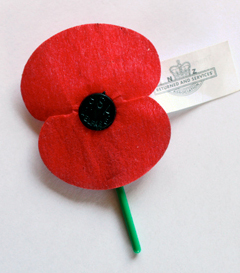
Back Pabi coch (symbol) Welsh Remembrance Poppy German Amapola del recuerdo Spanish شقایق یادبود Persian Campagne du Coquelicot French リメンブランス・ポピー Japanese Remembrance poppy Dutch Poppy appeal NB Remembrance poppy Polish Papoila da lembrança Portuguese
A remembrance poppy is an artificial flower worn in some countries to commemorate their military personnel who died in war. Remembrance poppies are produced by veterans' associations, which exchange the poppies for charitable donations used to give financial, social and emotional support to members and veterans of the armed forces.[1]
Inspired by the war poem "In Flanders Fields" and promoted by Moina Michael, they were first used near the end of World War I to commemorate British Empire and United States military casualties of the war. Madame Guérin established the first "Poppy Days" to raise funds for veterans, widows, orphans and liberty bonds, as well as charities such as the Red Cross.[2]
Remembrance poppies are most commonly worn in Commonwealth countries, where the symbol has been trademarked by veterans' associations for fundraising. Remembrance poppies in Commonwealth countries are often worn on clothing in the weeks leading up to Remembrance Day, with poppy wreaths also being laid at war memorials on that day. However, in New Zealand, remembrance poppies are most commonly worn on Anzac Day.[3]
The red remembrance poppy has inspired the design of several other commemorative poppies that observe different aspects of war and peace. In France, a bleuet de France is worn instead of a remembrance poppy to commemorate military personnel who died in war.
- ^ "Remembrance Day: Why do people wear poppies?". Newsround. BBC. 10 November 2019. Retrieved 23 November 2019.
- ^ Johnson, Heather. "Madame Guérin". Madame Guérin. Retrieved 28 May 2019.
- ^ "What is Anzac Day?". NZ Army. 8 August 2019. Archived from the original on 21 November 2019. Retrieved 23 November 2019.

